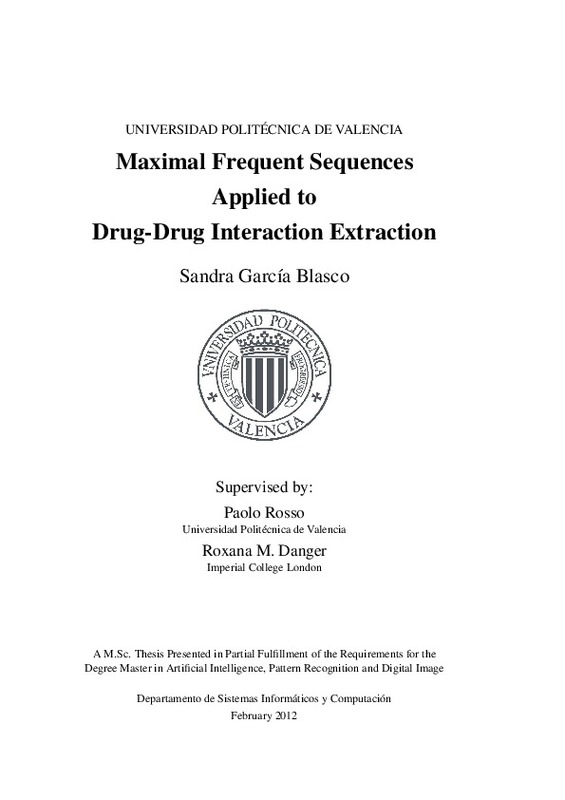JavaScript is disabled for your browser. Some features of this site may not work without it.
Buscar en RiuNet
Listar
Mi cuenta
Estadísticas
Ayuda RiuNet
Admin. UPV
Maximal frequent sequences applied to drug-drug interaction extraction
Mostrar el registro sencillo del ítem
Ficheros en el ítem
| dc.contributor.advisor | Rosso ., Paolo
|
es_ES |
| dc.contributor.advisor | Danger Mercaderes, Roxana María
|
es_ES |
| dc.contributor.author | García Blasco, Sandra
|
es_ES |
| dc.date.accessioned | 2012-05-02T12:31:18Z | |
| dc.date.available | 2012-05-02T12:31:18Z | |
| dc.date.created | 2012-01 | |
| dc.date.issued | 2012-05-02 | |
| dc.identifier.uri | http://hdl.handle.net/10251/15342 | |
| dc.description.abstract | A drug-drug interaction (DDI) occurs when the effects of a drug are modified by the presence of other drugs. DDIs can decrease therapeutic benefit or efficacy of treatments and this could have very harmful consequences in the patient's health that could even cause the patient's death. Knowing the interactions between prescribed drugs is of great clinical importance, it is very important to keep databases up-to-date with respect to new DDI. In this thesis we aim to build a system to assist healthcare professionals to be updated about published drug-drug interactions. The goal of this thesis is to study a method based on maximal frequent sequences (MFS) and machine learning techniques in order to automatically detect interactions between drugs in pharmacological and medical literature. With the study of these methods, the IT community will assist healthcare community to update their drug interactions database in a fast and semi-automatic way. In a first solution, we classify pharmacological sentences depending on whether or not they are describing a drug-drug interaction. This would enable to automatically find sentences containing drug-drug interactions. This solution is completely based in maximal frequent sequences (MFS) extracted from a set of test documents. In a second solution based in machine learning, we go further in the search and perform DDI extraction, determining if two specific drugs appearing in a sentence interact or not. This can be used as an assisting tool to populate databases with drug-drug interactions. The machine learning classifier is trained with several features i.e., bag of words, word categories, MFS, token and char level features and drug level features. The classifier we used was a Random Forest. This system was sent to the DDIExtraction 2011 competition and reached the 6th position. Finally, we introduce Maximal Frequent Discriminative Sequences (MFDS), a novel method of sequential pattern discovery that extends the concept of MFS to adapt it to classification tasks. | es_ES |
| dc.format.extent | 87 | es_ES |
| dc.language | Inglés | es_ES |
| dc.publisher | Universitat Politècnica de València | es_ES |
| dc.rights | Reserva de todos los derechos | es_ES |
| dc.subject | Drug-drug interactions | es_ES |
| dc.subject | Information extraction | es_ES |
| dc.subject | Maximal frequent sequences | es_ES |
| dc.subject.classification | LENGUAJES Y SISTEMAS INFORMATICOS | es_ES |
| dc.subject.other | Máster Universitario en Inteligencia Artificial, Reconocimiento de Formas e Imagen Digital-Màster Universitari en Intel·Ligència Artificial: Reconeixement de Formes i Imatge Digital | es_ES |
| dc.title | Maximal frequent sequences applied to drug-drug interaction extraction | es_ES |
| dc.type | Tesis de máster | es_ES |
| dc.rights.accessRights | Abierto | es_ES |
| dc.contributor.affiliation | Universitat Politècnica de València. Servicio de Alumnado - Servei d'Alumnat | es_ES |
| dc.description.bibliographicCitation | García Blasco, S. (2012). Maximal frequent sequences applied to drug-drug interaction extraction. http://hdl.handle.net/10251/15342 | es_ES |
| dc.description.accrualMethod | Archivo delegado | es_ES |






